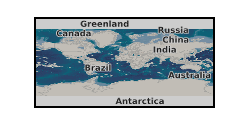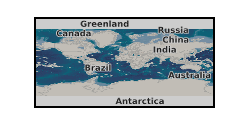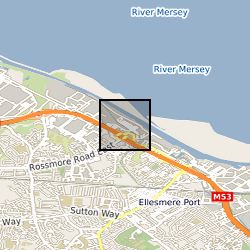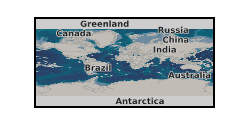Palynology
Type of resources
Topics
Keywords
Contact for the resource
Provided by
Years
Formats
Representation types
Update frequencies
Scale
-

This dataset comprises palynological counts on sediments from IODP Expedition 374 Site U1521 to the Ross Sea, collected on the RV JOIDES Resolution. Marine palynomorphs are counted in 23 samples, and 7 samples were counted for terrestrial palynomorphs (pollen and spores). Shipboard biostratigraphy and magnetostratigraphy suggests the samples are early Miocene in age (McKay et al., 2019, Proceedings of the International Ocean Discovery Program).
-

The co-evolution and geographical spread of trees and deep-rooting systems is widely proposed to represent the 'Devonian engine' of global change that drove the weathering of soil minerals and biogeochemical cycling of elements to exert a major influence on the Earth's atmospheric CO2 history. If correct, this paradigm suggests the evolutionary appearance of forested ecosystems through the Devonian (418-360 Myr ago) constitutes the single most important biotic feedback on the geochemical carbon cycle to emerge during the entire 540 Myr duration of the Phanaerozoic. Crucially, no link has yet been established between the evolutionary advance of trees and their geochemical impacts on palaeosols. Direct evidence that one has affected the other is still awaited, largely because of the lack of cross-disciplinary investigations to date. Our proposal addresses this high level 'earth system science' challenge. The overarching objective is to provide a mechanistic understanding of how the evolutionary rise of deep-rotting forests intensified weathering and pedogenesis that constitute the primary biotic feedbacks on the long-term C-cycle. Our central hypothesis is that the evolutionary advance of trees left geochemical effects detectable in palaeosols as forested ecosystems increased the quantity and depth of chemical energy transported into the soil through roots, mycorrhizal fungi and litter. This intensified soil acidification, increased the strength of isotopic and elemental enrichment in surface soil horizons, enhanced the weathering of Ca-Si and Ca-P minerals, and the formation of pedogenic clays, leading to long-term sequestration of atmospheric CO2 through the formation of marine carbonates with the liberated terrestrial Ca. We will investigate this research hypothesis by obtaining and analysing well-preserved palaeosol profiles from a time sequence of localities in the eastern North America through the critical Silurian-Devonian interval that represents Earth's transition to a forested planet. These palaeosol sequences will then be subjected to targeted geochemical, clay mineralogical and palaeontological analyses. This will allow, for the first time, the rooting structures of mixed and monospecific Mid-Devonian forests to be directly linked to palaeosol weathering profiles obtained by drilling replicate unweathered profiles. Weathering by these forests will be compared with the 'control case' - weathering by pre-forest, early vascular land plants with diminutive/shallow rooting systems from Silurian and lower Devonian localities. These sites afford us the previously unexploited ability to characterize the evolution of plant-root-soil relationships during the critical Silurian-Devonian interval, whilst at the same time controlling for the effects of palaeogeography and provenance on palaeosol development. Applying geochemical analyses targeted at elements and isotopes that are strongly concentrated by trees at the surface of contemporary soils, and which show major changes in abundance through mineral weathering under forests, provides a powerful new strategy to resolve and reconstruct the intensity and depth of weathering and pedogenesis at different stages in the evolution of forested ecosystems. The project is tightly focused on "improving current knowledge of the interaction between the evolution of life and the Earth", which represents one of the three high level challenges within NERC's Earth System Science Theme.
-

Extant euglenids from cultures LM and SEM images of living euglenids and euglenids post acetolysis Fossil material (recovered by standard palynological analysis) LM, SEM and TEM images of fossil materials from:- (i) The Torridonian of Scotland (ii) The Nonesuch Formation of Michigan, USA (iii) The 'fish beds' of the Silurian Inliers of the Midland Valley of Scotland.
-

All type and figured calcareous microfossils and palynmorphs held in the BGS collections are registered using the prefix 'MPK'. To date MPK1 to 13400 have been used. Information includes name, locality, geological details and journal details.
-

Database of samples taken from the Norham Westmains Farm borehole for isotope, thin section, palynology and fossil analysis. Westmains Farm, Norham, Berwick-upon-Tweed NT 91589 48135. BGS borehole ID NT94NW20.
-

The datasets consist of a spreadsheets containing sporomorph and biomarker data for 145 samples from Eocene sediments recovered by Integrated Ocean Drilling Programme Expedition 318. We studied palynology (pollen and dinocysts) and palaeothermometry based on Glycerol Dialkyal Glycerol Tetraethers (GDGTs) to a sedimentary record from the Wilkes Land margin, East Antarctica, recovered by the Integrated Ocean Drilling Program (IODP Expedition 318 Site U1356). These data sets provide the framework for a terrestrial climate reconstruction for the early Eocene of Antarctica. Further details of the data and their interpretation may be found in Pross et al. (2012), doi:10.1038/nature11300 and Bijl et al. (2013), PNAS, doi/10.1073/pnas.1220872110 The associated NERC grant is NE/I00646X/1 and NE/I00646X/2.
-

Four data tables are included: 1. Rock-Eval 6 pyrolysis and stable isotope data: includes sample number; Depth in meters; S1, S2, S3, present day hydrogen index, present day oxygen index in milligram hydrocarbons per grams of rock; Tmax in degrees Celsius; total organic carbon (TOC), pyrolyzed carbon (PC), remaining carbon (RC) in %; proportion of TOC that is pyrolyzed in % ; δ13C in ‰. 2. Palynological counts: raw counts of the palynofacies analysis. Includes MPA (micropalaeontology sample number), SSK (subsample Keyworth) number provided by the National Geological Repository; Depth in meters; the raw counts grouped by Heterogeneous amorphous organic matter (AOM), Homogeneous AOM, Phytoclasts, Spores and Pollen, Fungal debris and Mineral Matter. 3. Thermal Maturity as random mean vitrinite reflectance data: includes SSK sample number, depth in meters; mean random vitrinite reflectance (%Rr), Standard Deviation (SD) and the number of measurements taken for each sample (n). 4. Spore counts: Includes MPA (micropalaeontology sample number), SSK (subsample Keyworth) number provided by the National Geological Repository; Depth in meters; raw counts of spores identified in selected samples. All the data are based on sample materials from the Holywell Shale Formation from the Ellesmere Port 1 Borehole. These data are in support of: Hennissen et al.’s The Holywell Shale Formation in the Blacon Basin: resource potential in the Geological Society of London Special Publications.
-

The BGS Stratigraphical Masterpack Series aims to provide high quality biostratigraphical information modules for industry. It is envisaged that the majority of clients will be among the exploration, extraction, construction and consultancy sectors. The topics of these packages are designed, as far as possible,to be relevant to industrial needs by, for example, focusing on a particular frontier exploration area or documenting a fossil group of major interest. They act as practical desk-top guides for routine reference work and are also the basis for in-house staff training. The latest Masterpacks are PC based. There are four titles currently available for purchase from BGS: 1.Reference Collection of British Jurassic Dinoflagellates 2.Jurassic Dinoflagellate Cysts from Skye, NW Scotland 3.Stratigraphic Masterpack on Carboniferous Palynostratigraphy - The Arctic to North Africa 4.Palaeozoic Palynostratigraphy of North Africa, The Middle East & Gulf Region: An Integrated Database
 NERC Data Catalogue Service
NERC Data Catalogue Service